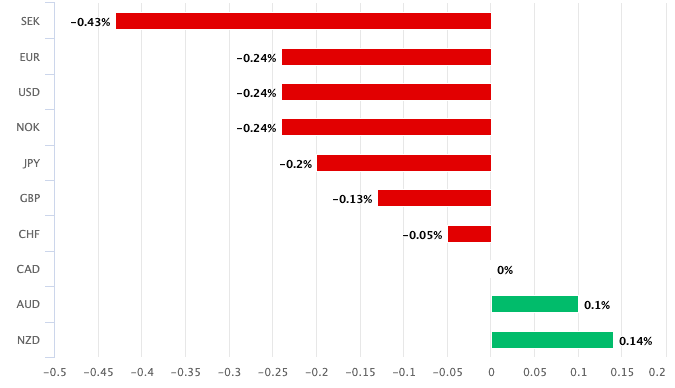Canadian Dollar Retreats As Markets Bet Bank Of Canada's Next Move Is A Cut
- Written by: Gary Howes
-

Image © Bank of Canada
The Canadian Dollar was softer after investors lowered the odds of another interest rate hike from the Bank of Canada following its latest interest rate decision and assessment of the economic outlook.
The Bank of Canada maintained interest rates at 5.0% on October 25, a move that was widely expected, ensuring the foreign exchange market's reaction function was always heavily dependent on the tone struck by the central bank.
In this regard, Governor Tiff Macklem and his team offered a downbeat assessment of the outlook, lowering growth projections while raising inflation forecasts.
Typically the lifting of inflation forecasts would raise the odds of further remedial rate hikes, a supportive development for the Canadian Dollar.
But higher inflation and lower growth also paint a picture of an economy that risks entering into a stagflationary setup, something that is rarely supportive of a currency's outlook.
"The BoC has kept its options open to hike rates again at upcoming meetings, though we think that the Bank’s more downbeat assessment on Canadian growth ensures that it is now done with its tightening cycle. Financial markets appear to be in agreement, with swaps currently assigning a greater chance that the next move in rates will be a cut, rather than another hike," says Matthew Ryan, Head of Market Strategy at global financial services firm Ebury.
The market's move to assign greater weight to the odds of a cut is weighing on the Canadian Dollar, which has fallen to a 7-month low against the U.S. Dollar, with USD/CAD going to 1.3775.
The Pound to Canadian Dollar exchange rate is higher by 0.15% at 1.6733, and the Euro to Canadian Dollar exchange rate is up a third of a per cent at 1.4590.
In fact, the Canadian Dollar is down against all its G10 peers, apart from the Australian and New Zealand Dollars, where some marginal gains are noted.

Above: CAD performance in the wake of the BoC October statement. Set up a daily rate alert email to track your exchange rate OR set an alert for when your ideal exchange rate is triggered ➡ find out more.
In a statement, the Bank of Canada said there was clear evidence that monetary policy was working; therefore, there was little appetite on the Governing Council to move rates beyond 5.0%.
It is clear the Bank is concerned that inflation is not falling back to the 2.0% target fast enough as it revised higher its outlook for inflation, mainly on account of firmer energy prices.
Beyond the recent rise in energy prices are other pockets of concern: "structural pressures" in Canada's housing market (surging demand due to record immigration and supply that can't meet demand), as well as stickiness in services inflation, are all slowing the return to target, said the Bank.
The Bank now expects inflation to be about 3.5% through to about the middle of next year. As excess supply in the economy increases, inflation should ease further in 2024 and reach 2% in 2025.
However, the Bank does not signal any immediate urge to act on these disappointing developments in inflation's trajectory.
Sure, it said it stands ready to raise interest rates again, but that is as far as the 'hawkish' element of the guidance goes.
The statement emphasised on a number of occasions that supply in the economy was outstripping demand, which is a fundamentally deflationary situation that the Bank believes recent rate hikes can take credit for.
"Estimates of the output gap suggest the economy is now roughly in balance or even in slight excess supply," said the statement. "The data suggest demand and supply are now approaching balance. With the economy expected to move into excess supply this year and with growth anticipated to be weak for the next few quarters, price pressures should ease further."
The lowering of growth forecasts only added to the sombre assessment and likely encouraged markets to discount further rate hikes:
"With consumer spending expected to remain subdued through most of 2024, we’ve revised down our growth outlook. Growth in gross domestic product is forecast to remain below 1% for the next several quarters before picking up in late 2024 and rising to 2½% in 2025."
"This weak GDP forecast has resulted in a decrease in Canada bond yields and the value of the CAD," says Mohamad Al-Saraf, Associate, FX and Rates Strategy, at Danske Bank.
Today's developments don't sing out as bullish for the Canadian Dollar, which can continue to underperform its major peers in the short term.

